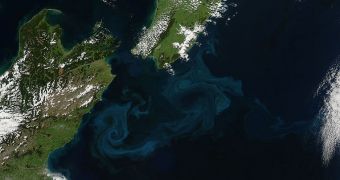Each spring, the surface of oceans gets covered up in blooms, features that are caused by massive growth spurs of phytoplankton. These are microscopic organisms, that form the basis of the oceanic food chain. They represent an essential component in all marine ecosystems, and as such are indispensable to the survival of all other marine species. For the last five decades, researchers have believed that the organisms multiply and bloom in the spring due to increasing temperatures, but a new study challenges that idea.
Researchers at the Oregon State University in Corvallis, led by botany researcher Michael Behrenfeld, say that their data show that phytoplankton actually begins piling up during the winter. While it's true that conditions in the spring are more favorable for the organisms' multiplication, this doesn't mean that they disappear from the oceans during the winter, the experts say. Their idea makes sense, considering that a phytoplankton bloom can grow to cover thousands of square miles of water, thus becoming visible from satellites. According to the Oregon group, the new data “strongly contradict” existing ideas on the life cycle these organisms have, OurAmazingPlanet reports.
“The old theory made common sense and seemed to explain what people were seeing. It was based on the best science and data that were available at the time, most of which was obtained during the calmer seasons of late spring and early summer. But now we have satellite remote sensing technology that provides us with a much more comprehensive view of the oceans on literally a daily basis,” Behrenfeld explains. He adds that phytoplankton blooms actually begin very early on, in the fall and winter, only to culminate in the spring. This discovery was made possible by employing state-of-the-art technology.
“To understand phytoplankton abundance, we've been paying way too much attention to phytoplankton growth and way too little attention to loss rates, particularly consumption by zooplankton. When zooplankton are abundant and can find food, they eat phytoplankton almost as fast as it grows. What the satellite data appear to be telling us is that the physical mixing of water has as much or more to do with the success of the bloom as does the rate of phytoplankton photosynthesis. Big blooms appear to require deeper wintertime mixing,” the expert concludes. He is also the author of a new paper detailing the findings, which appears in the April issue of the esteemed scientific journal Ecology.

 14 DAY TRIAL //
14 DAY TRIAL //